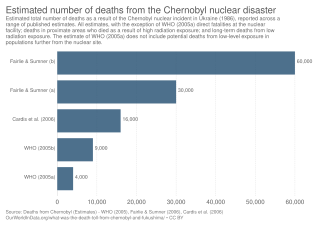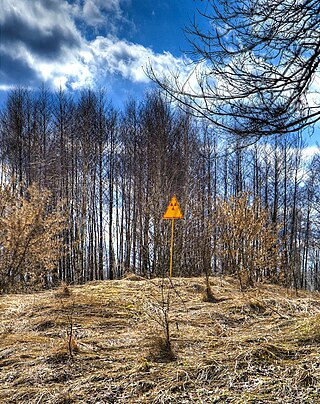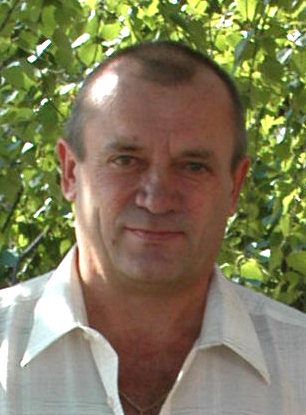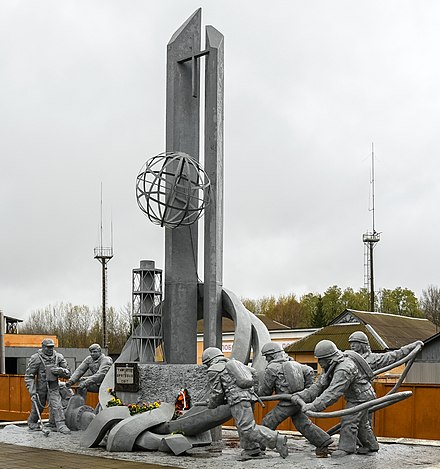
Chernobyl or Chornobyl is a partially abandoned city in the Chernobyl Exclusion Zone, situated in the Vyshhorod Raion of northern Kyiv Oblast, Ukraine. Chernobyl is about 90 kilometres (60 mi) north of Kyiv, and 160 kilometres (100 mi) southwest of the Belarusian city of Gomel. Before its evacuation, the city had about 14,000 residents. While living anywhere within the Chernobyl Exclusion Zone is technically illegal today, authorities tolerate those who choose to live within some of the less irradiated areas, and around 1,000 people live in Pripyat today.

A nuclear and radiation accident is defined by the International Atomic Energy Agency (IAEA) as "an event that has led to significant consequences to people, the environment or the facility. Examples include lethal effects to individuals, large radioactivity release to the environment, reactor core melt." The prime example of a "major nuclear accident" is one in which a reactor core is damaged and significant amounts of radioactive isotopes are released, such as in the Chernobyl disaster in 1986 and Fukushima nuclear disaster in 2011.

The Chernobyl Nuclear Power Plant Zone of Alienation is an officially designated exclusion zone around the site of the Chernobyl nuclear reactor disaster. It is also commonly known as the Chernobyl Exclusion Zone, the 30-Kilometre Zone, or The Zone.

The Chernobyl Nuclear Power Plant is a nuclear power plant undergoing decommissioning. ChNPP is located near the abandoned city of Pripyat in northern Ukraine 16.5 kilometers (10 mi) northwest of the city of Chernobyl, 16 kilometers (10 mi) from the Belarus–Ukraine border, and about 100 kilometers (62 mi) north of Kyiv. The plant was cooled by an engineered pond, fed by the Pripyat River about 5 kilometers (3 mi) northwest from its juncture with the Dnieper.

The Chernobyl disaster began on 26 April 1986 with the explosion of the No. 4 reactor of the Chernobyl Nuclear Power Plant, near the city of Pripyat in the north of the Ukrainian SSR, close to the border with the Byelorussian SSR, in the Soviet Union. It is one of only two nuclear energy accidents rated at seven—the maximum severity—on the International Nuclear Event Scale, the other being the 2011 Fukushima nuclear disaster in Japan. The initial emergency response and subsequent mitigation efforts involved more than 500,000 personnel and cost an estimated 18 billion roubles—roughly US$68 billion in 2019, adjusted for inflation. It is considered the worst nuclear disaster in history.

The 1986 Chernobyl disaster triggered the release of radioactive contamination into the atmosphere in the form of both particulate and gaseous radioisotopes. As of 2022, it was the world's largest known release of radioactivity into the environment.

Chernobyl liquidators were the civil and military personnel who were called upon to deal with the consequences of the 1986 Chernobyl nuclear disaster in the Soviet Union on the site of the event. The liquidators are widely credited with limiting both the immediate and long-term damage from the disaster.

Valery Alekseyevich Legasov was a Soviet inorganic chemist and a member of the Academy of Sciences of the Soviet Union. He is primarily known for his efforts to contain the 1986 Chernobyl disaster. Legasov also presented the findings of an investigation to the International Atomic Energy Agency (IAEA) at the United Nations Office at Vienna (UNOV), detailing the actions and circumstances that led to the explosion of Reactor No. 4 at the Chernobyl Nuclear Power Plant.
The Chernobyl disaster is the world's worst nuclear accident to date.

Anatoly Stepanovich Dyatlov was a Soviet engineer who was the deputy chief engineer for the Chernobyl Nuclear Power Plant. He supervised the safety test which resulted in the 1986 Chernobyl disaster, for which he served time in prison as he was blamed for not following the safety protocols. He was released due to health concerns in 1990. Later investigations found that reactor design flaws were a more significant factor than operator error, although some safety procedures were not followed.

The Red Forest is the ten-square-kilometre (4 sq mi) area surrounding the Chernobyl Nuclear Power Plant within the Exclusion Zone, located in Polesia. The name "Red Forest" comes from the ginger-brown colour of the pine trees after they died following the absorption of high levels of ionizing radiation as a consequence of the Chernobyl nuclear disaster on 26 April 1986. In the post-disaster cleanup operations, the Red Forest was bulldozed and buried in "waste graveyards"; the site remains one of the most contaminated areas in the world today.

Mykola Mykolayovych Melnyk, also known as Nikolai Melnik, was a Soviet-Ukrainian pilot and liquidator hero renowned for his high-risk helicopter mission on the dangerously-radioactive Chernobyl Nuclear Power Plant building immediately after the 1986 Chernobyl disaster.

The Pripyat amusement park is an abandoned amusement park located in Pripyat, Ukraine. It was to have its grand opening on 1 May 1986, in time for the May Day celebrations, but these plans were cancelled on 26 April, when the Chernobyl disaster occurred a few kilometers away. Several sources report that the park was opened for a short time on 27 April before the announcement to evacuate the city was made. These reports claim that the park was hurriedly opened to distract Pripyat residents from the unfolding disaster nearby. However, these claims remain largely unsubstantiated and unsupported. Pripyat residents have not been able to recall for sure if the park was opened following the disaster, but considering the lack of panic at the time of the disaster and subsequent evacuation, there would seem to be no need to distract people. In any case, the park—and its ferris wheel in particular—have become a symbol of the Chernobyl disaster.
The Chernobyl disaster, considered the worst nuclear disaster in history, occurred on 26 April 1986 at the Chernobyl Nuclear Power Plant in the Ukrainian Soviet Socialist Republic, then part of the Soviet Union, now in Ukraine. From 1986 onward, the total death toll of the disaster has lacked consensus; as peer-reviewed medical journal The Lancet and other sources have noted, it remains contested. There is consensus that a total of approximately 30 people died from immediate blast trauma and acute radiation syndrome (ARS) in the seconds to months after the disaster, respectively, with 60 in total in the decades since, inclusive of later radiation induced cancer. However, there is considerable debate concerning the accurate number of projected deaths that have yet to occur due to the disaster's long-term health effects; long-term death estimates range from up to 4,000 for the most exposed people of Ukraine, Belarus, and Russia, to 16,000 cases in total for all those exposed on the entire continent of Europe, with figures as high as 60,000 when including the relatively minor effects around the globe. Such numbers are based on the heavily contested linear no-threshold model.
To date, the nuclear accidents at the Chernobyl (1986) and Fukushima Daiichi (2011) nuclear power plants, are the only INES level 7 nuclear accidents.

The Azure Swimming Pool is one of the indoor swimming pools in the abandoned city of Pripyat, Ukraine, which was affected by the 1986 Chernobyl nuclear disaster.

Chernobyl is a 2019 historical drama television miniseries that revolves around the Chernobyl disaster of 1986 and the cleanup efforts that followed. The series was created and written by Craig Mazin and directed by Johan Renck. It features an ensemble cast led by Jared Harris, Stellan Skarsgård, Emily Watson, and Paul Ritter. The series was produced by HBO in the United States and Sky UK in the United Kingdom.

Chernobyl: Abyss, also titled Chernobyl 1986, is a 2021 Russian disaster film directed by and starring Danila Kozlovsky. The film centres on a fictionalised firefighter who becomes a liquidator during the Chernobyl disaster. The film was released in Russia by Central Partnership on 15 April 2021, and was subsequently picked up by Netflix in July 2021.















